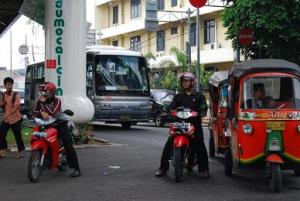By Catherine and Raffi
Jakarta is home to an estimated 13 million people. It was hard to imagine what this would be like until we drove through it from the airport last night. Below the highway, an ocean of red tile roofs and groups of skyscrapers streamed by. We were overwhelmed by the sights of boulevards along boulevards, cars driving on the opposite side of the road, motorcycles and tuk-tuks everywhere weaving in and out, massive drooping power lines, and buildings easily hundreds of stories high plastered with advertisements and logos of multinational companies. Everywhere it looks like concrete and tropical vegetation are competing for space, closely intertwined in this urban jungle. Despite the sweltering heat and humidity, this morning we donned the appropriate formal wear (after a delicious hotel breakfast) and headed off to meetings!
After morning interviews with an environmental journalist from Reuters (Catherine) and representatives from the Ministry of Religion (Raffi), we both visited Marco Kusumawijama. Marco is an urban planner who has worked extensively with the World Bank and the UN on implementing participatory development projects. He is now spearheading the Citizens’ Coalition for Jakarta 2030, an urban planning group that has just finished planning a lawsuit against the government for violating its recently ratified freedom of information law. (By recently, we mean that this law was passed at the end of April 2010.) Fortunately, the government has kindly agreed to address their demands after getting wind of the lawsuit, according to Marco.
We found it interesting to think of city planning in a place this chaotic and unruly — Jakarta just seems inherently unplanned. Marco moved to the city after studying architecture in East Timor and Belgium, and is a fierce defendant of its “paradoxical vitality within a chaotic space.” Such chaos breeds classic urban problems such as dreadful traffic and sprawling slums. Poor preparedness also fails to deal with issues that are more specific to the area, like flooding caused by daily afternoon tropical torrents. After ending our conversation in the rain on Marco’s porch we hopped in the hotel car just in time for the 5:30 traffic jam on the way back. Our long ride was confirmation that the story our half-Indonesian friend at Yale told us was not hyperbole–he and his parents, when visiting, would actually give up on dinner out after waiting in traffic for an hour and wade through stationary cars to grab food from a street vendor.
Marco also spoke about overseeing the reconstruction of hundreds of homes in Banda Aceh that were ravaged by the infamous 2004 Boxing Day tsunami. He criticized the lack of attention some of the larger NGOs and organizations, such as the Red Cross and the World Bank, paid to the smaller details in prioritizing the needs of the Acehnese post-tsunami. Christina, our emeritus production editor, will be hashing out the specifics of this process in her article, while Catherine and Jasmine will expand on the urban planning needs of Jakarta in theirs.
If Marco left us with any profound thought, it is this: “Modern city planning should not reduce the complexity of the city.”
